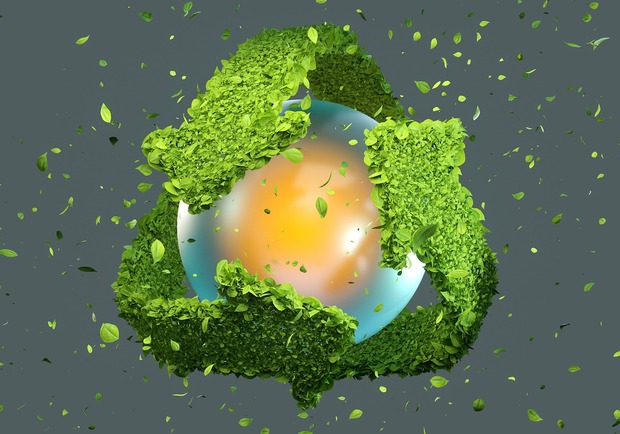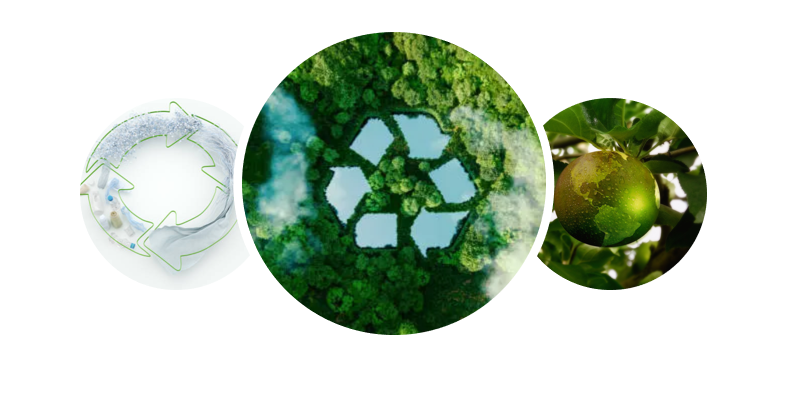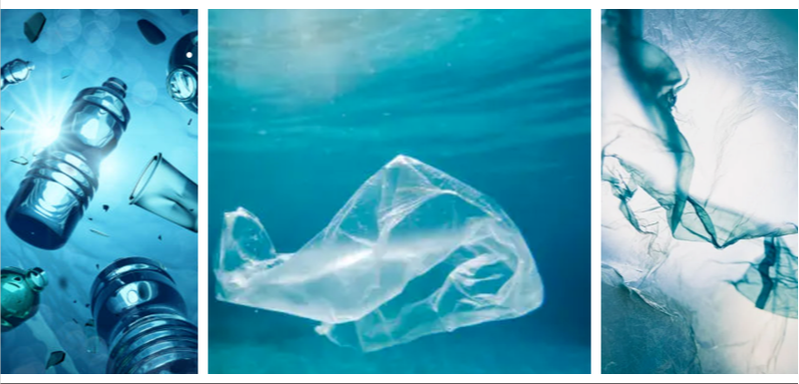Plastics Circularity
Circularity in regards to resources means keeping the specific resource in question in a perpetual sustainable cycle by using it more efficiently, recovering it from waste and old products, unitizing it in new products, and repeating the cycle as long as possible. Following this logic, plastics circularity simply refers to a circular plastics economy in which the material is kept in a perpetual cycle that allows it to keep providing value for as long as possible. Reduce, reuse, repurpose and recycle are key elements that should be considered in a plastics circular economy. Plastics circularity is essentially a plastics sustainability cycle that has the goal of diminishing losses of plastic and its value as well as to avoid any subsequent damages or consequences that result from breaking the cycle. These consequences may include plastic waste, damage to the environment, loss of a valuable resource, plastics scarcity, and other consequences. Plastics need to be returned to the supply chain instead of being disposed of in land fills or in the environment, because after all plastics are a valuable resource like any other and we should aim to keep extracting value from them for as long as we can.
Circularity in regards to resources means keeping the specific resource in question in a perpetual sustainable cycle by using it more efficiently, recovering it from waste and old products, unitizing it in new products, and repeating the cycle as long as possible. Following this logic, plastics circularity simply refers to a circular plastics economy in which the material is kept in a perpetual cycle that allows it to keep providing value for as long as possible. Reduce, reuse, repurpose and recycle are key elements that should be considered in a plastics circular economy. Plastics circularity is essentially a plastics sustainability cycle that has the goal of diminishing losses of plastic and its value as well as to avoid any subsequent damages or consequences that result from breaking the cycle. These consequences may include plastic waste, damage to the environment, loss of a valuable resource, plastics scarcity, and other consequences. Plastics need to be returned to the supply chain instead of being disposed of in land fills or in the environment, because after all plastics are a valuable resource like any other and we should aim to keep extracting value from them for as long as we can.
How to Promote Plastics Circularity
There are several key components that can promote plastics circularity as part of a new plastics sustainability model. These include increasing demand for recycled plastic materials, redesigning products with sustainability in mind, adopting new recycling methods and technologies, supportive legislation and industry standards, and keeping plastics in the cycle and out the environment. Tackling all of these issues is easier said than done but it is certainly feasible and if all of these issues are addressed then a circular plastics economy can surely become a reality.
Increasing Demand for Recycled Plastics
A vital step in achieving plastics circularity is to boost demand for recycled plastics, but unfortunately, there are some deterrents in the way that prevent post consumer recycled (PCR) plastics from being implemented on a widescale. The largest deterrent is likely the price as currently it is much cheaper to use virgin plastics than recycled materials. In such a competitive industry manufacturers are likely to source the most affordable raw materials available and in this case virgin plastics are most affordable. Recycled plastics provide great environmental benefits but offer very little in the way of economic incentives. One could argue that a change in market dynamics in which recycled plastics become the primary option through a change in consumer preferences could provide the economic incentives for firms to adopt PCR plastics, however, this change will likely require time to take effect. Strengthening demand in end markets will be key and firms will have a major part to play in stimulating that demand. Companies will need to make a commitment to use PCR plastics wherever they can to drive vital end market growth, only then will plastics circularity start to become viable.
Another issue is that recycled plastic materials are currently in short supply. Although there is a lot of development happening in regards to recycling and plastics circularity, there still isn't enough recycled material to cover the needs of the entire industry. In fact, a study carried out by Bain & company suggests that recycled plastics will only constitute 10- 14% of total plastics consumption in 2030 which accounts for 50-70 million tons of plastic. With that said, its important for plastics producers to develop their plastic recycling capabilities to be able to offer their customers sustainable solutions. Better technical expertise, accelerating industrialization of the recycling sector, and better waste sorting solutions will also go a long way in providing the industry with the needed feedstock and raw materials to engender a circular plastics economy.
Redesigning Products With Sustainability in Mind
Manufacturers of plastic products have little incentive to consider their products' end of life impact, nevertheless, achieving plastics circularity will require firms to make product recyclability and sustainability a front of mind focus. In this sense, firms should take note of industry guidelines that promote product recyclability, and embed these principles in their design and development processes. These principles may include reducing the use of adhesives, labels, and colorants as well as sticking to using fewer types of polymer in order to simplify the recycling process. Companies and industry institutions should also attempt to develop guidelines for the recycling of more complex plastic products such as flexible packaging or other items.
Adopting new Recycling Methods and Technologies
Plastics circularity is complex to achieve and our current recycling methods, infrastructure, and technologies seem to fall short in making this longstanding goal into a reality. Chemical recycling has been a option that many think of as a highly beneficial solution due to its ability to strip plastics down to their original chemical building blocks and then reuse them to produce new materials. Some are skeptical of whether or not chemical recycling can represent a real solution due to lack of infrastructure and investment. Nonetheless, currently intense innovation efforts are underway in several industries. Most notably firms in the consumer goods industry are making substantial investments contributing to the development of the technology. In fact, several CPG firms including L' Oreal, PepsiCo, and Evian have partnered with Loop Industries a leading innovator in chemical recycling. New technologies could also be implemented in other supportive roles such as sorting, collection, and processing. Some firms have started developing solutions in plastic waste management; such is the case for waste management firm Suez (now Veolia) which opened the most advanced used packaging sorting facility in Europe. Using a cutting edge optical system the plant is able to process 100 Kilotons annually. Other advancements being considered include secondary material recovery facilities (MRFs) which can aggregate residual material streams from primary MRFs and remove lower value plastics and cartons more effectively. Several low carbon and optimized resins are also being developed in order to aid plastics circularity efforts. Innovation, as well as adopting new technologies and recycling methods will be key in achieving plastics circularity.
Improving Legislation and Standards
Developing better policies and standards around plastic waste management will go a long way in developing a circular plastics economy. Governments, plastic producers, consumers, and recyclers will need to work together on developing better policies that will aid plastics circularity. a great deal of effort will have to be put into improving consumer education and behaviors revolving around waste sorting. All stakeholders will need to encourage and support investment and funding of new technologies and infrastructure improvements. Additionally, all will need to agree on a standards and taxonomy. There are also specific actions governments can take to support plastics circularity. A good example would be to restrict the use of virgin plastics or set up a tax on them, thereby supporting the use of recycled plastics. They could also implement minimum requirements of recycled content in plastics, which would promote the use of the recycled material.
Increasing Demand for Recycled Plastics
A vital step in achieving plastics circularity is to boost demand for recycled plastics, but unfortunately, there are some deterrents in the way that prevent post consumer recycled (PCR) plastics from being implemented on a widescale. The largest deterrent is likely the price as currently it is much cheaper to use virgin plastics than recycled materials. In such a competitive industry manufacturers are likely to source the most affordable raw materials available and in this case virgin plastics are most affordable. Recycled plastics provide great environmental benefits but offer very little in the way of economic incentives. One could argue that a change in market dynamics in which recycled plastics become the primary option through a change in consumer preferences could provide the economic incentives for firms to adopt PCR plastics, however, this change will likely require time to take effect. Strengthening demand in end markets will be key and firms will have a major part to play in stimulating that demand. Companies will need to make a commitment to use PCR plastics wherever they can to drive vital end market growth, only then will plastics circularity start to become viable.
Another issue is that recycled plastic materials are currently in short supply. Although there is a lot of development happening in regards to recycling and plastics circularity, there still isn't enough recycled material to cover the needs of the entire industry. In fact, a study carried out by Bain & company suggests that recycled plastics will only constitute 10- 14% of total plastics consumption in 2030 which accounts for 50-70 million tons of plastic. With that said, its important for plastics producers to develop their plastic recycling capabilities to be able to offer their customers sustainable solutions. Better technical expertise, accelerating industrialization of the recycling sector, and better waste sorting solutions will also go a long way in providing the industry with the needed feedstock and raw materials to engender a circular plastics economy.
Redesigning Products With Sustainability in Mind
Manufacturers of plastic products have little incentive to consider their products' end of life impact, nevertheless, achieving plastics circularity will require firms to make product recyclability and sustainability a front of mind focus. In this sense, firms should take note of industry guidelines that promote product recyclability, and embed these principles in their design and development processes. These principles may include reducing the use of adhesives, labels, and colorants as well as sticking to using fewer types of polymer in order to simplify the recycling process. Companies and industry institutions should also attempt to develop guidelines for the recycling of more complex plastic products such as flexible packaging or other items.
Adopting new Recycling Methods and Technologies
Plastics circularity is complex to achieve and our current recycling methods, infrastructure, and technologies seem to fall short in making this longstanding goal into a reality. Chemical recycling has been a option that many think of as a highly beneficial solution due to its ability to strip plastics down to their original chemical building blocks and then reuse them to produce new materials. Some are skeptical of whether or not chemical recycling can represent a real solution due to lack of infrastructure and investment. Nonetheless, currently intense innovation efforts are underway in several industries. Most notably firms in the consumer goods industry are making substantial investments contributing to the development of the technology. In fact, several CPG firms including L' Oreal, PepsiCo, and Evian have partnered with Loop Industries a leading innovator in chemical recycling. New technologies could also be implemented in other supportive roles such as sorting, collection, and processing. Some firms have started developing solutions in plastic waste management; such is the case for waste management firm Suez (now Veolia) which opened the most advanced used packaging sorting facility in Europe. Using a cutting edge optical system the plant is able to process 100 Kilotons annually. Other advancements being considered include secondary material recovery facilities (MRFs) which can aggregate residual material streams from primary MRFs and remove lower value plastics and cartons more effectively. Several low carbon and optimized resins are also being developed in order to aid plastics circularity efforts. Innovation, as well as adopting new technologies and recycling methods will be key in achieving plastics circularity.
Improving Legislation and Standards
Developing better policies and standards around plastic waste management will go a long way in developing a circular plastics economy. Governments, plastic producers, consumers, and recyclers will need to work together on developing better policies that will aid plastics circularity. a great deal of effort will have to be put into improving consumer education and behaviors revolving around waste sorting. All stakeholders will need to encourage and support investment and funding of new technologies and infrastructure improvements. Additionally, all will need to agree on a standards and taxonomy. There are also specific actions governments can take to support plastics circularity. A good example would be to restrict the use of virgin plastics or set up a tax on them, thereby supporting the use of recycled plastics. They could also implement minimum requirements of recycled content in plastics, which would promote the use of the recycled material.
Keeping Plastics Out of the Environment and In the Cycle
Plastics circularity can be achieved through these various efforts. Working on all of these aspects should aid in keeping plastics in the cycle and out of oceans and natural environments. Increasing demand for recycled plastics and ensuring that demand can be met is an essential component to making plastics circularity viable. Redesigning products for recyclability and sustainability will also boost circularity by simplifying the recycling process. Likewise adopting new methods and technologies will further close the loop in the cycle by boosting efficiency and providing new ways to recycle more complex products. Improving legislation and policies around plastics waste management will also aid circularity efforts by improving consumer education, raising awareness and investment, and providing standards and regulations for the use and disposal of plastics. Plastics are a valuable renewable resource and thus the primary goal of plastics circularity should be to keep plastics in the cycle and to extract value from them indefinitely.


